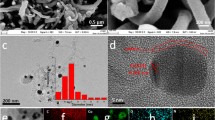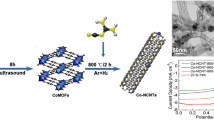Abstract
It is a big challenge to prepare non-rare metal and high-activity electrocatalysts for oxygen reduction reaction (ORR). In this paper, a cobalt/carbon nanotubes/chitosan composite gel was synthesized and then annealed under nitrogen atmosphere to yield the cobalt and nitrogen co-modified carbon nanotubes (Co–N-CNTs) nanocomposite electrocatalysts. In this strategy, the cobalt component considerably enhanced the ORR activity and improved the degree of graphitic structure to increase the electronic conductivity. The chitosan served as sustainable source for nitrogen doping. The Co–N-CNTs exhibit excellent oxygen reduction reaction (ORR) electrocatalytic activity due to the synergetic effect of Co species and N-doping. The Co–N-CNTs also deliver excellent methanol tolerance and superior long-term durability to that of commercial Pt/C, making it a promising ORR electrocatalyst.




Similar content being viewed by others
References
He JR, Chen YF, Lv WQ, Wen KC, Xu C, Zhang WL, Li YR, Qin W, He WD. From metal–organic framework to Li2S@C–Co–N nanoporous architecture: a high-capacity cathode for lithium–sulfur batteries. ACS Nano. 2016;10(12):10981.
He JR, Lv WQ, Chen YF, Wen KC, Chen X, Zhang WL, Li YR, Wu Q, He WD. Tellurium-impregnated porous cobalt-doped carbon polyhedra as superior cathodes for lithium–tellurium batteries. ACS Nano. 2017;11(8):8144.
Zhang LH, Wu SS, Wan Y, Huo YF, Luo YC, Yang MY, Li MC, Lu ZG. Mn3O4/carbon nanotube nanocomposites recycled from waste alkaline Zn–MnO2 batteries as high-performance energy materials. Rare Met. 2017;36(5):442.
Wu SS, Zhu YG, Huo YF, Luo YC, Zhang LH, Wan Y, Nan B, Cao LJ, Wang ZY, Li MC, Yang MY, Cheng H, Lu ZG. Bimetallic organic frameworks derived CuNi/carbon nanocomposites as efficient electrocatalysts for oxygen reduction reaction. Sci Mater China. 2017;60(7):654.
Zhao XL, Li F, Wang RN, Seo JM, Choi HJ, Jung SM, Mahmood J, Jeon IY, Baek JB. Electrocatalyts: controlled fabrication of hierarchically structured nitrogen-doped carbon nanotubes as a highly active bifunctional oxygen electrocatalyst. Adv Funct Mater. 2017;27(9):1605717.
Li T, Liu H, Shi P, Zhang Q. Recent progress in carbon/lithium metal composite anode for safe lithium metal batteries. Rare Met. 2018;37(6):449.
Li J, Liu WW, Zhou HM, Liu ZZ, Chen BR, Sun WJ. Anode material NbO for Li-ion battery and its electrochemical properties. Rare Met. 2018;37(2):118.
Ren Q, Wang H, Lu XF, Tong YX, Li GR. Recent progress on MOF-derived heteroatom-doped carbon-based electrocatalysts for oxygen reduction reaction. Adv Sci. 2018;5(3):1700515.
Cao LJ, Tao PP, Li MC, Lyu FC, Wang ZY, Wu SS, Wang WX, Huo YF, Huang L, Lu ZG. Synergistic effects of C/α-MoC and Ag for efficient oxygen reduction reaction. J Phys Chem Lett. 2018;9(4):779.
Yang F, Abadia M, Chen CQ, Wang WK, Li L, Zhang LB, Rogero C, Chuvilin A, Knez M. Design of active and stable oxygen reduction reaction catalysts by embedding CoxOy nanoparticles into nitrogen-doped carbon. Nano Res.2017;10(1):97.
Kim SJ, Mahmood J, Kim C, Han GF, Kim SW, Jung SM, Zhu G, Yoreo JJD, Kim G, Baek JB. Defect-free encapsulation of Fe0 in 2D fused organic networks as a durable oxygen reduction electrocatalyst. J Am Chem Soc. 2018;140(5):1737.
Yang L, Zeng XF, Wang WC, Cao DP. Recent progress in MOF-derived, heteroatom-doped porous carbons as highly efficient electrocatalysts for oxygen reduction reaction in fuel cells. Adv Funct Mater. 2018;28(7):1704537.
Nie Y, Li L, Wei Z. Recent advancements in Pt and Pt-free catalysts for oxygen reduction reaction. Cheminform. 2015;46(25):2168.
Wei PJ, Yu GQ, Naruta Y, Liu JG. Covalent grafting of carbon nanotubes with a biomimetic heme model compound to enhance oxygen reduction reactions. Angew Chem. 2014;53(26):6659.
Qiao M, Meysami SS, Ferrero GA, Xie F, Meng H, Grobert N, Titirici MM. Low-cost chitosan-derived N-doped carbons boost electrocatalytic activity of multiwall carbon nanotubes. Adv Funct Mater. 2018;28(16):1707284.
Yang J, Sun H, Liang H, Ji H, Song L, Gao C, Xu H. A highly efficient metal-free oxygen reduction electrocatalyst assembled from carbon nanotubes and graphene. Adv Mater. 2016;47(33):4606.
Wu G, Zelenay P. Nanostructured nonprecious metal catalysts for oxygen reduction reaction. Acc Chem Res. 2013;46(8):1878.
You SJ, Gong XB, Wang W, Qi DP, Wang XH, Chen XD, Ren NQ. Enhanced cathodic oxygen reduction and power production of microbial fuel cell based on noble-metal-free electrocatalyst derived from metal–organic frameworks. Adv Energy Mater. 2016;6(1):1501497.
Kumar MNVR. A review of chitin and chitosan applications. React Funct Polym. 2000;46(1):1.
Zhao JJ, Liu YM, Quan X, Chen S, Yu HT, Zhao HM. Nitrogen-doped carbon with a high degree of graphitization derived from biomass as high-performance electrocatalyst for oxygen reduction reaction. Appl Surf Sci. 2017;396:986.
Lu ZY, Wang J, Huang SF, Hou YL, Li YG, Zhao YP, Mu SC, Zhang JJ, Zhao YF. N, B-codoped defect-rich graphitic carbon nanocages as high performance multifunctional electrocatalysts. Nano Energy. 2017;42:334.
Wu ZY, Chen P, Wu QS, Yang LF, Pan Z, Wang Q. Co/Co3O4/C–N, a novel nanostructure and excellent catalytic system for the oxygen reduction reaction. Nano Energy. 2014;8:118.
Shang CQ, Li MC, Wang ZY, Wu SF, Lu ZG. Electrospun nitrogen-doped carbon nanofibers encapsulating cobalt nanoparticles as efficient oxygen reduction reaction catalysts. Chemelectrochem. 2016;3(9):1437.
Sun Y, Shen ZC, Xin SL, Ma L, Xiao CH, Ding SJ, Li F, Gao GX. Ultrafine Co-doped ZnO nanoparticles on reduced graphene oxide as an efficient electrocatalyst for oxygen reduction reaction. Electrochim Acta. 2016;224:561.
Yasuda S, Furuya A, Uchibori Y, Kim J, Murakoshi K. Iron–nitrogen-doped vertically aligned carbon nanotube electrocatalyst for the oxygen reduction reaction. Adv Funct Mater. 2016;26(5):738.
Yuan HD, Zhang WK, Wang JG, Zhou GM, Zhuang ZZ, Luo JM, Huang H, Gan YP, Liang C, Xia Y. Facilitation of sulfur evolution reaction by pyridinic nitrogen doped carbon nanoflakes for highly-stable lithium–sulfur batteries. Energy Storage Mater. 2018;10:1.
Fu Y, Yu HY, Jiang C, Zhang TH, Zhan R, Li XW, Li JF, Tian JH, Yang RZ. NiCo alloy nanoparticles decorated on N-doped carbon nanofibers as highly active and durable oxygen electrocatalyst. Adv Funct Mater. 2017;28(9):1705094.
Su TM, Shao Q, Qin ZZ, Guo ZH, Wu ZL. Role of interfaces in two-dimensional photocatalyst for water splitting. ACS Catal. 2018;8(3):2253.
Liu YM, Su Y, Quan X, Fan XF, Chen S, Yu HT, Zhao HM, Zhang YB, Zhao JJ. Facile ammonia synthesis from electrocatalytic N2 reduction under ambient conditions on N-doped porous carbon. ACS Catal. 2018;8(2):1186.
Tang C, Wang B, Wang HF, Zhang Q. Defect engineering toward atomic Co–Nx–C in hierarchical graphene for rechargeable flexible solid Zn–air batteries. Adv Mater. 2017;29(37):1703185.
Guo DH, Shibuya R, Akiba C, Saji S, Kondo T, Nakamura J. Active sites of nitrogen-doped carbon materials for oxygen reduction reaction clarified using model catalysts. Science. 2016;351(6271):361.
Acknowledgements
This study was financially supported by the National Natural Science Foundation of China (No. 21671096 and 21603094), the Natural Science Foundation of Guangdong Province (No. 2016A030310376), the Guangdong Special Support for the Science and Technology Leading Young Scientist (No. 2016TQ03C919), the Guangdong Innovative and Entrepreneurial Research Team Program (No. 2016ZT06G587) and the Basic Research Project of the Science and Technology Innovation Commission of Shenzhen (No. JCYJ20170412153139454 and JCYJ20170817110251498).
Author information
Authors and Affiliations
Corresponding authors
Rights and permissions
About this article
Cite this article
Zhu, YG., Shang, CQ., Wang, ZY. et al. Co and N co-modified carbon nanotubes as efficient electrocatalyst for oxygen reduction reaction. Rare Met. 40, 90–95 (2021). https://doi.org/10.1007/s12598-019-01270-x
Received:
Revised:
Accepted:
Published:
Issue Date:
DOI: https://doi.org/10.1007/s12598-019-01270-x




